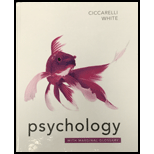
Introduction:
There are three ways to examine the cognitive development. One of the ways is found in works of Jean Piaget. He developed a theory from detailed observations of children and infants. Piaget believed that children form schemes as they experience new events and situations. Piaget proposed four distinct stages of cognitive development that occurs from infancy to adulthood: sensorimotor stage, preoperational stage, concrete operations, and formal operations.
Answer to Problem 10TY
Correct answer:
In the Piaget’s stage of concrete operations, the child become capable of understanding conservation. Therefore, option d. is correct.
Option d. is given as “concrete operations”.
Explanation of Solution
Reason for the correct statement:
In concrete operations stage which is around the ages of 7-12, a child becomes capable of conservation and reversible thinking. They are able to identify objects with respect to their characteristics. At concrete operation stage, a child is able to think logically and is very much able to understand analogies.
Hence, option d. is correct.
Reasons for the incorrect statements:
Option a. is given as “sensorimotor”.
Sensorimotor is the first stage of cognitive development, in which child uses its senses and motor abilities to learn things in its surrounding (world). Hence, it is a wrong answer.
Option b. is given as “preoperational”.
This is the second Piaget’s stages in which the child becomes capable of symbolic thinking. Hence, it is a wrong answer.
Option c. is given as “formal operations”.
Formal operation is the last Piaget’s stage in which abstract thinking becomes possible in the child. This involves not only understanding of concepts but also depth thinking regarding possibilities and impossibilities. Hence, it is a wrong answer.
Hence, options a., b., and c. are incorrect.
Concrete operation is the stage of cognitive development in which a child becomes capable of reversible thinking and conservation.
Want to see more full solutions like this?
Chapter 8 Solutions
PSYCHOLOGY:MARG.GLOSS.-W/ACCESS>CUSTOM<
- What are three methods for dissemination of information that school counselors can use after learning from the modules of the “504 Online Introductory Tutorial” (https://sss.usf.edu/resources/topic/section504/504course/Module1/index.html Bureau of Exceptional Education and Student Services (2015))? Please write in a narrative format and include in-text citations and references.arrow_forwardWhat are three professional best practices that school counselors can implement or can recommend in schools from the modules of the “504 Online Introductory Tutorial” (https://sss.usf.edu/resources/topic/section504/504course/Module1/index.html Bureau of Exceptional Education and Student Services (2015))? Please write in a narrative format and include in-text citations and references.arrow_forwardWhat are three interventions or programs school counselors can implement in schools after learning from the “504 Online Introductory Tutorial” (https://sss.usf.edu/resources/topic/section504/504course/Module1/index.html Bureau of Exceptional Education and Student Services (2015))? Please write in a narrative format and include in-text citations and references.arrow_forward
- What are three strategies school counselors use in schools after learning from the “504 Online Introductory Tutorial” (https://sss.usf.edu/resources/topic/section504/504course/Module1/index.html Bureau of Exceptional Education and Student Services (2015))? Please write in a narrative format and include in-text citations and references.arrow_forwardWhat are the three most relevant principles school counselors need to be aware from the modules of the “504 Online Introductory Tutorial” (https://sss.usf.edu/resources/topic/section504/504course/Module1/index.html Bureau of Exceptional Education and Student Service (2015))? Please write in a narrative format and include in-text citations and references.arrow_forwardWhat are three most important knowledge that a school counselor can gain from the modules of “504 online introductory Tutorial” (https://sss.usf.edu/resources/topic/section504/504course/Module1/index.html Bureau of Exceptional Education and Student Service (2015))?. Please write in a narrative format and include in-text citations and references.arrow_forward
- I need help finding 30 interesting research peer review articles on evolutionary psychology& culturalarrow_forwardRead this article: https://www.unr.edu/nevada-today/news/2013/school-uniform-study Respond the following questions Briefly summarize the source. State why the source is credible. State how the source is relevant to the research question : Why are mandatory uniform policies the best choice for schools?arrow_forwardwhy choose the dharma center of worship Massachusetts for a visit. Describe the exterior in detailarrow_forward
- what is it like to be in the Dharma center of worship massachusetts? what was the most interesting thing?how does this place help your better understanding of religious practices?arrow_forwardDescribe the interior decoration in detail of the dharma center in Cambridge massachusetts.arrow_forwardCan you help me find 20 research peer review article on psychology evolutinary&cultural that has do with indiaarrow_forward
 Ciccarelli: Psychology_5 (5th Edition)PsychologyISBN:9780134477961Author:Saundra K. Ciccarelli, J. Noland WhitePublisher:PEARSON
Ciccarelli: Psychology_5 (5th Edition)PsychologyISBN:9780134477961Author:Saundra K. Ciccarelli, J. Noland WhitePublisher:PEARSON Cognitive PsychologyPsychologyISBN:9781337408271Author:Goldstein, E. Bruce.Publisher:Cengage Learning,
Cognitive PsychologyPsychologyISBN:9781337408271Author:Goldstein, E. Bruce.Publisher:Cengage Learning, Introduction to Psychology: Gateways to Mind and ...PsychologyISBN:9781337565691Author:Dennis Coon, John O. Mitterer, Tanya S. MartiniPublisher:Cengage Learning
Introduction to Psychology: Gateways to Mind and ...PsychologyISBN:9781337565691Author:Dennis Coon, John O. Mitterer, Tanya S. MartiniPublisher:Cengage Learning Psychology in Your Life (Second Edition)PsychologyISBN:9780393265156Author:Sarah Grison, Michael GazzanigaPublisher:W. W. Norton & Company
Psychology in Your Life (Second Edition)PsychologyISBN:9780393265156Author:Sarah Grison, Michael GazzanigaPublisher:W. W. Norton & Company Cognitive Psychology: Connecting Mind, Research a...PsychologyISBN:9781285763880Author:E. Bruce GoldsteinPublisher:Cengage Learning
Cognitive Psychology: Connecting Mind, Research a...PsychologyISBN:9781285763880Author:E. Bruce GoldsteinPublisher:Cengage Learning Theories of Personality (MindTap Course List)PsychologyISBN:9781305652958Author:Duane P. Schultz, Sydney Ellen SchultzPublisher:Cengage Learning
Theories of Personality (MindTap Course List)PsychologyISBN:9781305652958Author:Duane P. Schultz, Sydney Ellen SchultzPublisher:Cengage Learning





